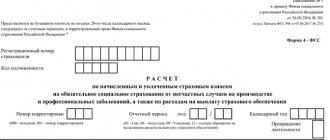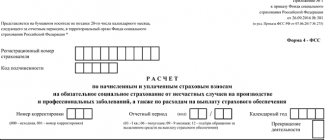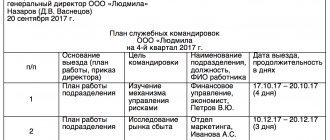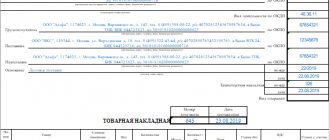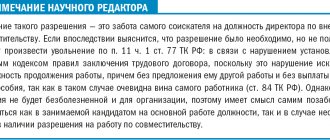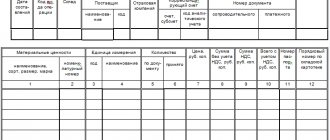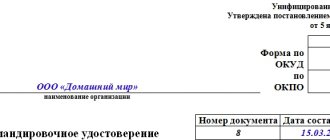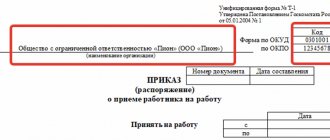Inventory label INV-2 is an auxiliary document used when conducting an inventory of an enterprise’s inventory in cases where an organization has a large amount of property, which cannot be counted in one day. In the article we will tell you about the INV-2 form (inventory label), provide a form and a sample for filling it out.
At the end of each day, labels are compiled for each storage location. Upon completion of the inventory, the information from the labels is compiled into a single inventory list, which is certified by the responsible persons and submitted to the accounting department for subsequent processing.
The INV-2 form is convenient to use in cases where an enterprise has large-scale warehouses, the goods in which cannot be quickly counted, as well as when warehouse premises are dispersed. That is, the main purpose of the inventory label is to speed up and simplify the inventory process at enterprises with a wide range of products.
Inventory procedure
In order to carry out an inventory, the director of the company issues an appropriate order. It states
- requirement for this event,
- persons who must take part in it,
- the tasks that are assigned to them,
- employees responsible for the execution of superior orders.
The purpose of the inventory is to monitor the presence and safety of inventory, search and identify property subject to write-off (due to obsolescence, irreparable breakdowns, etc.), as well as assess the conditions of storage and maintenance of the organization’s property.
During inventory activities, all property is checked, counted and verified with documentation, primarily related to accounting. Based on the results of the event, special reporting acts are drawn up, including an inventory list.
If it is not possible to carry out an inventory at one time, inventory labels are generated at intermediate intervals.
They contain preliminary information about the results of the inspection, which will subsequently be clarified. Before the next stage of the inventory, the room in which the property being inspected is stored is sealed.
Production of labels and stickers for inventory
We can produce inventory stickers
, labels, and stickers to order.
It is possible to add additional label features, such as high-adhesive super glue
or use
a self-destructive material with a guarantee against re-sticking
. The inventory of your own property will be properly marked and will be available for automatic accounting using a barcode. The price-etiketka company offers specialized inventory labels with sequential numbering or selective code, with a counterfeit protection code.
Samples are available at each office.
inventory labels, for availability - call!
Each type of sticker has its own minimum circulation
— from 1000 pcs.
Marking for inventory is different in that the inventory number must be printed on it. At large enterprises, where the inventory process is automated according to the inventory number with duplication of a bar code and logo printing.
Automation of inventory allows you to speed up the process of checking and counting fixed assets, goods and materials, while reducing errors.
In what cases is property inspection carried out?
Carrying out inventory activities is necessary in the following cases:
- when selling property, transferring it for rent or buying it out;
- when changing materially responsible employees;
- in case of theft, abuse of official position (for the purpose of profit),
- damage and damage to property;
- before preparing annual financial statements;
- as part of the reorganization or liquidation of the company;
- after various kinds of unforeseen situations and natural disasters.
Who conducts property inspections
A special commission is appointed to carry out the inventory. It includes employees of the enterprise from different structural divisions, including a representative of the management level, a specialist from the accounting department, a warehouse employee, etc. If necessary, people from what is called “outside” are also included in the commission, for example, experts from specialized auditing companies .
Among the commission there is a chairman and ordinary members. The chairman bears maximum responsibility for conducting an inspection of the property and preparing all accompanying papers.
General Inventory Label Information
- The INV-2 form is unified. And although today unified document standards have been canceled, most organizations still prefer to use previously mandatory forms. This is due to the fact that such forms contain all the necessary data, they are convenient and easy to fill out. In addition, they can be modified as necessary by removing or adding the necessary lines.
- Information in the document can be entered electronically or by hand (if a printed version is used). There are no clear instructions for completing the form. The only thing that needs to be taken into account is that it must be signed by the responsible persons (in this case, the autograph of one member of the commission is sufficient) and stamped - if the use of stamps for endorsing internal papers is enshrined in the local documents of the company.
- An inventory label is generated in a single original copy and kept by the responsible employee.
- If there are any errors in the label, unlike many other forms, they can be corrected - this document does not apply to strict accounting forms. To edit, you need to cross out the incorrect information and write the correct information above or next to it (when there is free space), confirming the correction with the signature of the employee who fills out the document.
Sample of filling out the INV-2 form: inventory label
First, enter the following data into the form:
- name of the company where the inventory is carried out;
- structural unit whose property is being checked (if necessary);
- on the left, in a special plate - the details of the organization (OKPO code, type of activity according to OKVED (also in the form of a numerical value));
- reference to the order or instruction of the management of the enterprise on the basis of which inspection activities are carried out;
- date of inventory (day-month-year of its beginning and end);
- inventory label number and date of its preparation.
Below is a plate in which information about inventory items, calculated and accounted for, is entered. Here it means:
- storage location (details - shelf, rack, cell number);
- name and number (by nomenclature);
- all identification characteristics: brand (model), grade (category), profile, size, etc.;
- unit of measurement (according to OKEI code - in words, in numbers);
- quantity of inventory items available.
Next, the document must be signed by one of the commission members and the financially responsible person.
On the reverse side of the form is the date when the actually available property was counted, again the number of remaining inventory items (in words) and the signature of the person who accepted them for storage.
What is document INV-2
Form INV-2, introduced into business circulation by the State Statistics Committee in the resolution “On approval of forms for recording inventory results” dated August 18, 1998 No. 88, is used for preliminary accounting of raw materials, products, goods and other inventory items (material assets) in warehouses when conducting an inventory at the enterprise in cases where:
- the commission that conducts the inventory takes more than 1 day to calculate inventory items and record information about them in a special inventory (another unified form, designated INV-3);
- the enterprise is quite large-scale, and for more accurate accounting of inventory items, the use of auxiliary primary forms is required, one of which is the INV-2 document.
The INV-2 form is fully consistent with its second name, since a label is usually understood as a form that complements another document that is considered the main one. In this case, it complements the main inventory list. Please note that it cannot be used instead of the INV-3 form, since these documents are completely different in structure.
Read about the rules for filling out INV-3 in the article “Unified form No. INV-3 - form and sample.”
You can download the form for the main inventory of goods and materials according to the INV-3 form on our website.
The auxiliary function of the inventory label is expressed in the fact that, in particular, it records:
- location of goods and materials;
- coordinates of cells and racks in which inventory items are stored;
- main characteristics of inventory items, for example, brand and grade;
- the number of inventory items of a certain type located in a specific location.
The INV-2 document is filled out by representatives of the inventory commission in the amount of 1 copy per 1 warehouse facility. It is signed by only one of the commission members, as well as the person responsible for storing the MC. The form should be stored in the places where the inventory items recorded in it are located, that is, at the appropriate warehouse facility. Subsequently, the data from the INV-2 document is used when filling out the main inventory compiled according to the INV-3 form.
Read about the document reflecting the results of the inventory of fixed assets in the material “Unified Form No. INV-1 - Form and Sample.”
When to Apply an Inventory Label
This form is designed to record intermediate inventory results. If, due to the large number of goods and materials, the commission does not have time to complete the inspection in one day, then a separate document is drawn up that records the preliminary results - an inventory label. Form INV-2 is drawn up in this way before completing the inventory based on the results of the inventory. And the information that is reflected in the label is subsequently used to compile an inventory list of goods and materials (form INV-3 is used for this).
How to properly issue an inventory label
Requirements for the content of primary accounting documents are given in Art. 9 of the Law on Accounting No. 402-FZ dated December 6, 2011. The details given in Article 9 (name and date of the document; content and value of the fact of economic life that are reflected in the document; name of the economic entity, positions and signatures of responsible persons, etc.) must be contained in the label, if you do not draw it up according to a unified form. If you use the unified INV-2 form, then all the necessary details are contained there.
Thus, the unified form includes:
- the name of the organization, its OKPO code and the name of the structural unit being inspected;
- details of the document-basis of the inventory (number and date of the order, instruction or resolution on conducting the inventory);
- inventory start and end date;
- details of the document itself (name, date, number);
- data about the place where inventory items are stored (shelf number, cell number, etc.);
- information about inventory items (name, quantity, grade, brand, etc.);
- Full name, position, signatures of the commission member and the responsible person;
- a note from the financially responsible person regarding the acceptance for storage of inventory items that were available on the day of the inspection.
INV-2 form form
Since this form is preliminary, the requirements for its design are somewhat simpler than for the final inventory forms. Unlike other forms, it does not need to be compiled in several copies; one is enough.
The signatures of all commission members are not required. The unified form provides for the signing of this document by one of the commission members. It is also signed by the person who is responsible for the safety of valuables in the warehouse.
If the inspection lasts more than one day, the premises where inventory items are stored should be sealed when the commission leaves (clause 2.12 of the Inventory Guidelines). According to the instructions given in Resolution No. 98, the inventory label remains in the storage location of the inspected inventory items.
The inventory label (INV-2 form) is recommended for use by Decree of the State Statistics Committee of August 18, 1998 No. 88. The form was a mandatory unified form until 2013. Since 2013, the given sample document can be used when carrying out inventory activities in its original form or a new form can be developed based on it.
Unified forms used to document inventory results
| Form number | Form name | Application procedure | Base |
| INV-1 | Inventory list of fixed assets | Used to document the results of the inventory of fixed assets. The inventory list is compiled in two copies. It is signed by members of the commission and the person responsible for the safety of fixed assets Objects of fixed assets are entered in the inventory indicating individual characteristics (brief description, inventory and serial numbers) Objects of the same type are entered into the inventory in one line indicating the total quantity only if the following conditions are simultaneously met: – objects have equal value; – objects arrived simultaneously to one unit; – objects are accounted for on one group accounting inventory card (OS-6a) Column 9 “Passport number” is filled in for fixed assets containing precious metals and stones For fixed assets accepted for lease, an inventory is drawn up in triplicate separately for each lessor, indicating the lease term. The third copy is sent to the lessor A separate inventory is compiled for fixed assets that are not suitable for use and cannot be restored. It indicates the time of commissioning and the reasons that led these objects to unsuitability (damage, complete wear and tear, etc.) | clause 1.2 of the resolution of the State Statistics Committee of Russia dated August 18, 1998 No. 88 |
| INV-1a | Inventory list of intangible assets | Used to document the results of the inventory of intangible assets. It is signed by the responsible persons of the commission and the person responsible for the safety of documents certifying the organization’s right to intangible assets. One copy is transferred to the accounting department, and the second remains with the person(s) responsible for the safety of documents. | clause 1.2 of the resolution of the State Statistics Committee of Russia dated August 18, 1998 No. 88 |
| INV-2 | Inventory label | The label is used to record the actual availability of material assets in warehouses during the inventory period: – raw materials; – finished products; – goods; – other material assets An inventory tag is attached to inspected valuables. This must be done if during the day the commission was unable to count all inventory items and fill out the inventory list. The label is filled out in one copy by the responsible persons of the inventory commission and stored together with the recalculated inventory items at their location Data from form No. INV-2 are used to fill out the inventory list of goods and materials (form No. INV-3) | clause 1.2 of the resolution of the State Statistics Committee of Russia dated August 18, 1998 No. 88 |
| INV-3 | Inventory list of inventory items | It is used to reflect data on the actual availability of inventory items in storage locations and at all stages of their movement in the organization. The inventory list is compiled in two copies separately for each location and financially responsible person or group of persons Column 9 “Passport number” is filled in for material assets containing precious metals and stones | clause 1.2 of the resolution of the State Statistics Committee of Russia dated August 18, 1998 No. 88 |
| INV-4 | Inventory report of shipped inventory items | Used when registering an inventory of shipped goods and materials For inventory purposes, the specified inventory items are divided into two types: – shipped valuables for which the payment period has not yet arrived; – shipped valuables not paid by customers on time Separate acts are drawn up for each type of inventory. In the “Note” column on inventory items shipped but not paid on time by buyers, the name of the buyer is given for each individual shipment In the event of transfer of ownership of shipped goods and materials in a special manner (when using balance sheet account 45), the data for filling out column 13 is recalculated into negotiated, contract prices | clause 1.2 of the resolution of the State Statistics Committee of Russia dated August 18, 1998 No. 88 |
| INV-5 | Inventory list of inventory items accepted for safekeeping | It is used for inventory of goods and materials accepted for safekeeping. The inventory is compiled in two copies by the responsible persons of the inventory commission based on actual data. It is signed by the responsible persons of the commission and the financially responsible person(s) | clause 1.2 of the resolution of the State Statistics Committee of Russia dated August 18, 1998 No. 88 |
| INV-6 | Act of inventory of inventory items in transit | It is used to identify the quantity and cost of inventory items that are in transit at the time of inventory. Such valuables are understood as goods and materials that have not yet reached the buyer, the ownership of which has already been transferred to him. Inventory is carried out on the basis of settlement documents received from suppliers. The act is drawn up in two copies and signed by the responsible persons of the inventory commission | clause 1.2 of the resolution of the State Statistics Committee of Russia dated August 18, 1998 No. 88 |
| INV-8 | Inventory act of precious metals and products made from them | It is used for inventory of precious metals and products made from them in storage areas and in production. The act is drawn up in two copies by the responsible persons of the inventory commission. It is signed by the responsible persons of the commission and the financially responsible person(s) | clause 1.2 of the resolution of the State Statistics Committee of Russia dated August 18, 1998 No. 88 |
| INV-8a | Inventory inventory of precious metals contained in parts, semi-finished products, assembly units (assemblies), equipment, instruments and other products | It is used for inventory of precious metals contained in parts, semi-finished products, assembly units (assemblies), equipment, devices and other products. Data are based on net weight The inventory is compiled in two copies by the responsible persons of the inventory commission for each unit of the facility as a whole for the organization. It is signed by the responsible persons of the commission and the financially responsible person(s) | clause 1.2 of the resolution of the State Statistics Committee of Russia dated August 18, 1998 No. 88 |
| INV-9 | Act of inventory of precious stones, natural diamonds and products made from them | They are used for inventory of precious stones, natural diamonds and products made from them in storage areas and in production. The act is drawn up in two copies by the responsible persons of the inventory commission. It is signed by the responsible persons of the commission and the financially responsible person(s) | clause 1.2 of the resolution of the State Statistics Committee of Russia dated August 18, 1998 No. 88 |
| INV-10 | Inventory report of unfinished repairs of fixed assets | It is used for inventory of unfinished repairs of buildings, structures, machinery, equipment, power plants and other fixed assets. The act is drawn up by the responsible persons of the inventory commission in two copies based on checking the state of the work in kind. The data in columns 10 and 11 are used to identify internal reserves and are not reflected in accounting. If an unreasonable overexpenditure is detected (column 11), its causes are identified and appropriate corrections are made in accounting | clause 1.2 of the resolution of the State Statistics Committee of Russia dated August 18, 1998 No. 88 |
| INV-11 | Act of inventory of future expenses | It is used when inventorying deferred expenses. Drawed up by the responsible persons of the inventory commission in two copies. Members of the inventory commission check the amounts from documents confirming expenses (agreements, payment orders, etc.) with the amounts listed in account 97 Column 4 of the act indicates the total amount of costs (expenses) relating to future reporting periods Column 5 of the act indicates one of the following dates: – the date of actual expenses incurred, if they are one-time (one-time); – completion date of work, if they are related to work on the development of new equipment, production and other work carried out over a certain period of time | clause 1.2 of the resolution of the State Statistics Committee of Russia dated August 18, 1998 No. 88 |
| INV-15 | Cash inventory report | Used to reflect the results of an inventory of the actual availability of funds, various valuables and documents located in the organization’s cash desk The inventory results are documented in two copies. It is signed by all members of the commission and persons responsible for the safety of valuables | clause 1.2 of the resolution of the State Statistics Committee of Russia dated August 18, 1998 No. 88 |
| INV-16 | Inventory list of securities and forms of strict reporting documents | Used to reflect the results of an inventory of the actual availability of securities and strict reporting forms The inventory is drawn up in two copies, signed by the responsible persons of the inventory commission and the financially responsible person(s) If there are strict reporting document forms numbered with one number, a set of these documents is compiled indicating their number in it | clause 1.2 of the resolution of the State Statistics Committee of Russia dated August 18, 1998 No. 88 |
| INV-17 | Act of inventory of settlements with buyers, suppliers and other debtors and creditors | It is used to formalize the results of an inventory of settlements with buyers, suppliers and other debtors and creditors. The basis for drawing up the act is to identify from the documents the balances of the amounts listed in accounts 60, 62, 66, 67, 68, 69, 70, 71, 73, 75, 76. The act is drawn up in two copies. It is signed by the responsible persons of the inventory commission For these types of debt, a certificate must be attached to the settlement inventory report (appendix to form No. INV-17). It is drawn up before conducting an inventory of calculations and is the basis for drawing up an Act in form No. INV-17 | clause 1.2 of the resolution of the State Statistics Committee of Russia dated August 18, 1998 No. 88 |
| Appendix to form No. INV-17 | Help for the act of inventory of settlements with buyers, suppliers and other debtors and creditors | ||
| INV-18 | Comparison statement of the results of inventory of fixed assets | Used to reflect inventory results: - fixed assets; – intangible assets; – goods and materials, finished products; – other material assets for which deviations from accounting data were identified The comparison statements reflect the results of the inventory. Namely, discrepancies between indicators according to accounting data and inventory records Separate matching statements are compiled for the values taken into account on the balance sheet. These include valuables that are in safekeeping, rented or received for processing. The matching statement is drawn up in two copies by the accountant When filling out a comparison sheet to reflect the results of the inventory of intangible assets (form No. INV-18), columns 3, 8, 10 are not filled in | clause 1.2 of the resolution of the State Statistics Committee of Russia dated August 18, 1998 No. 88 |
| INV-19 | Comparison sheet of inventory inventory results | ||
| INV-22 | Order (decree, order) to conduct an inventory | Used for registration of inventories. An order is a written task specifying the content, volume, procedure and timing of the inventory of the inspected object. The order determines the personal composition of the inventory commission. It is signed by the head of the organization and presented to the chairman of the inventory commission | clause 1.2 of the resolution of the State Statistics Committee of Russia dated August 18, 1998 No. 88 |
| INV-23 | Logbook for monitoring the implementation of orders (decrees, instructions) on inventory | Used to register orders (decrees, instructions) on inventory | clause 1.2 of the resolution of the State Statistics Committee of Russia dated August 18, 1998 No. 88 |
| INV-24 | Act on the control check of the correctness of the inventory of valuables | Used to document the results of control checks of the correctness of the inventory | clause 1.2 of the resolution of the State Statistics Committee of Russia dated August 18, 1998 No. 88 |
| INV-25 | Logbook for control checks of the correctness of inventories | Used to register control checks of the correctness of the inventory of valuables | clause 1.2 of the resolution of the State Statistics Committee of Russia dated August 18, 1998 No. 88 |
| INV-26 | Statement of results identified by inventory | Used to document inventory results and control the correctness of its implementation | Resolution of the State Statistics Committee of Russia dated March 27, 2000 No. 26 |
* From January 1, 2013, unified forms of documents contained in albums of unified forms approved by the resolutions of the State Statistics Committee of Russia are not mandatory for use. Therefore, the organization has the right, at its own choice, to either develop the document form independently or use a unified form. Similar conclusions follow from the information of the Ministry of Finance of Russia dated December 4, 2012 No. PZ-10/2012.
** There are no forms of matching statements for this type of property and liabilities. To identify the results of the inventory, the act (inventory) itself is used, which combines the indicators of inventory inventories (acts) and matching statements.
Inventory label: general information about the document
The label is used in the process of recounting inventory items. The document is not independent; it is issued as an auxiliary form in the following cases:
- if the range of products being tested is so wide that its exact number cannot be calculated in 1 working day;
- if material assets subject to recalculation are located in several warehouses remote from each other.
Form INV-2 acts as a supplement to form INV-3. The document is drawn up in a single copy, typewritten or by hand. The basis for using data from a document when compiling inventories is the presence of completed required details and affixed signatures, and the absence of empty columns. Simultaneous registration with INV-3 is not allowed.
The completed label form must remain in storage in the warehouse where the values recalculated and reflected in the document are located. A separate form is filled out for each inspected premises. At the end of inventory activities, members of the commission transfer information from all labels to the inventory.
What documents are required to fill out the INV-2 form?
In order for the members of the inventory commission to begin their duties, it is necessary to determine their composition and appoint them by administrative document. By order, the manager determines the employees to be included in the commission, and also establishes for them the range of responsibilities associated with carrying out the inventory procedure. That is, before members of the commission fill out an inventory label, the order should be approved; the standard INV-22 form can be used.
Filling out the INV-2 label is carried out only if the commission members do not immediately enter data on the recalculated inventory items into the INV-3 inventory list. That is, information on the inventory of material or commodity assets is first entered into the label. Next, the inventory form INV-3 is filled out based on the data from the completed labels INV-2.
There is no need to transfer the label to the accounting department; it is initially stored together with the goods and materials, the information for which is given in it. After transferring the information to the inventory, the label remains in storage at the warehouse. Accounting needs an inventory of INV-3 to reflect inventory results and identify discrepancies.
INV-2: sample filling
The header of the document contains the following information:
- the name of the enterprise is given;
- indicates the department or warehouse where the inventory of goods and materials was carried out;
- OKPO and type of activity codes are entered;
- information about the order that is the basis for carrying out inventory activities;
- inventory period (written out from the order);
- number and date of issue of the label.
To correctly fill out INV-2, the form must contain information about the storage locations of inventory items, names of valuables, their units of measurement and nomenclature codes, and the number of units in stock. The storage location means not only the warehouse number, but more detailed information - the numbers of racks, shelves, cells in safes or cabinets, compartments. Converted values are indicated by location by actual location.
When specifying the name of the product, the brand and grade of the object are specified. It is allowed to provide information about the size of property assets. The item code must correspond to the warehouse numbering. Units of measurement are given in the form of text designation and OKEI code. The amount of valuables in the warehouse is reflected in numerical format and in words.
INV-2 is signed by the financially responsible person and a representative of the inventory commission. On the reverse side, the signature of the official of the enterprise who accepted for storage the property that has undergone the inventory procedure must be affixed. This signature indicates the employee’s consent to accept the values and confirms that the property objects in the warehouse are in the quantity indicated on the label. The completed form does not need to be submitted to the accounting department.
Related documents
- Sample. Pricing information (quarterly)
- Sample. Initial data for calculating the estimated cost of representative materials at the current price level. Form No. 1-ref
- Sample. Initial data from the contractor on the cost of operating construction machines. Form No. 2-ref.
- Sample. Calculation card. Form No. 82
- Sample. Map of the register of contributions of founders to the authorized capital of a liquidated enterprise
- Sample. Map of the register of long-term financial investments of enterprises
- Sample. Map of the register of property contributions of an enterprise to the authorized capital of established enterprises
- Sample. Real estate registry map
- Sample. Enterprise registry map
- Sample. Materials warehouse card. Form No. m-12
- Sample. Accounting card for low-value and high-wear items. Form No. MB-2
- Sample. Cash book. Form No. ko-4
- Sample. Book of accounting of income and expenses of individuals who have income from business activities
- Sample. Book of accounting of money accepted and issued by the cashier. Form No. ko-5
- Sample. Limit fence card. Form No. m-8
- Sample. Limit fence card. Form No. M-9
- Sample. Local estimates. Form No. 4-в
- Sample. Invoice is a requirement for release (internal movement) of materials. Form No. m-11
- Sample. Inventory of cash tickets sent for examination (instruction of the Central Bank of the Russian Federation dated 10/04/93 No. 18 (as amended on 02/26/96))
- Sample. Determining Average Percentage of Gross Income

